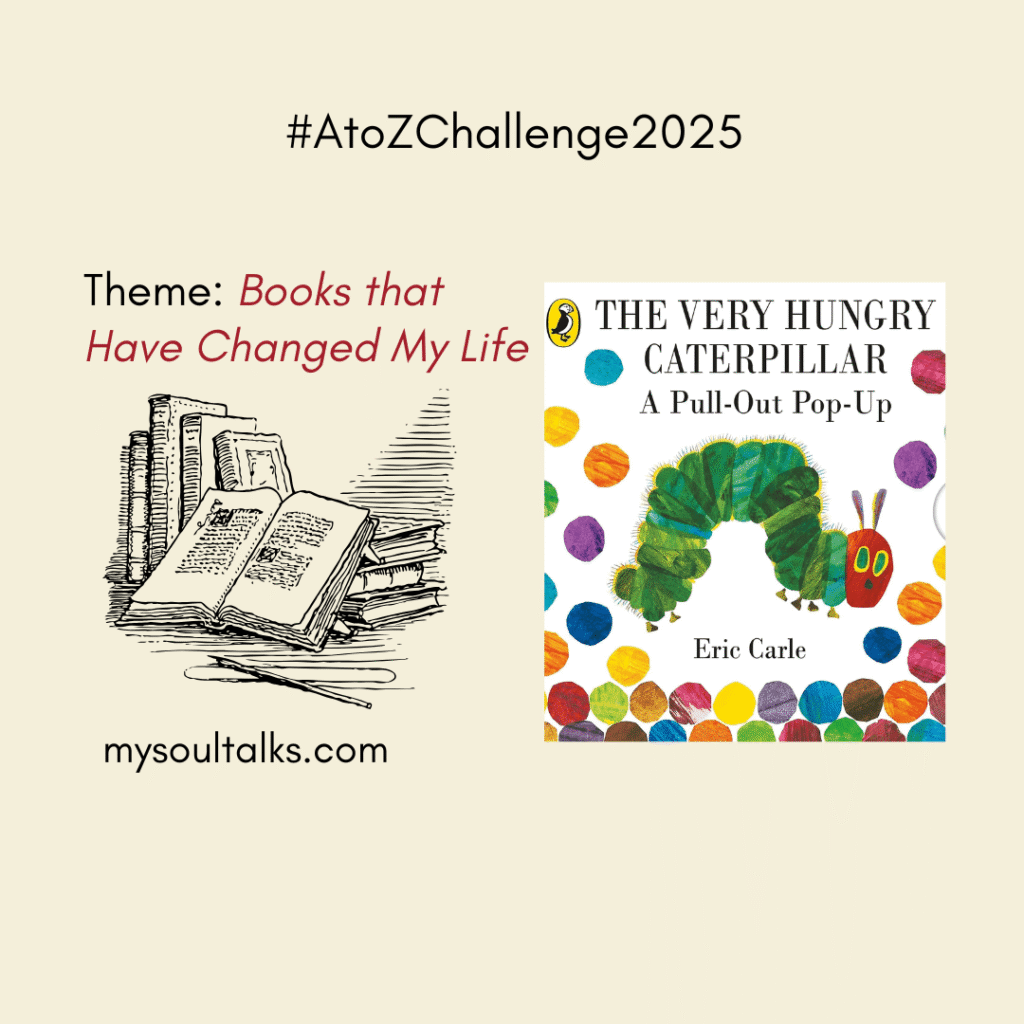I’m participating in the #AtoZ April Blogging Challenge 2025 and this will be my third year of joining the vibrant community that loves this one-of-a-kind creative challenge.
This year, my theme is—BOOKS THAT CHANGED MY LIFE—which means they are not just my favourite books, but they’ve also left a deep and lasting impact on me and continue to do so until this day. If you are stopping by this blog for the first time, please do leave your blog link, I’ll be happy to visit yours too. 🙂

The Very Hungry Caterpillar by Paulo Coelho

I’m still in the process of catching up with the letters and today it is V, so here goes one of my all-time favourite books from childhood. I’m going to be sharing about Eric Carle’s The Very Hungry Caterpillar today—which, for many of us is a timeless classic—a book that isn’t just one that I grew up with, but decades later, my son did too.
It was only years later, that I came to realise, how this beautifully illustrated book came with a quiet wisdom and a lasting impact on our young and impressionable minds, teaching us that even the tiniest of beginnings can and very often does, lead to the most beautiful transformations in life.
As a child, this book would always cast a spell on my imagination. The vibrant colours, the simple yet relatable narrative, and the lessons—everything just blended in, to create what became my earliest reading memories. It was sheer joy, to devour books, with not a care in the world. The fact that in our home, every member was a reader—my parents and grandparents were all readers too with an insatiable appetite for reading, only ensured that books were the surest and the quickest way to transport us into the realm of magic and beauty and wisdom.
For those who have not read the book—The Very Hungry Caterpillar is actually the story of a small caterpillar’s journey from being an egg to becoming a butterfly—a process that unfolds through the passage of days and an ever-growing appetite. Each page features the caterpillar eating through a series of increasingly diverse and abundant foods—from apples and pears to cake and sausage—before eventually forming a cocoon and emerging as a beautiful butterfly. .
One of the book’s most defining features is Eric Carle’s distinctive artwork. The bright, textured illustrations are both bold and inviting, and they were among the first images to truly grab my attention as a child. Years later, I recall a two-year old sitting on my lap, those little fingers tracing the caterpillar’s path, fascinated by the holes in the pages and the colorful foods he devoured. It’s obvious how these interactive elements were more than just entertaining—they invariably engaged the senses of the young readers and helped them connect physically with the story. You could say, this book was a classic experience with what it meant to feel a story, not just hear it.
Beyond its aesthetic charm, The Very Hungry Caterpillar was also a source of comfort. Its repetitive structure and predictable rhythm created a soothing, almost musical cadence that made it perfect for bedtime reading. My son would often request me to read it out to him and I mostly obliged, understanding how much joy it brought us as we’d bond over story time.
Reflecting on it now, I can see how this deceptively simple story shaped my understanding of growth, change, and curiosity in ways that extended far beyond childhood.
The most powerful impact the book had on me was how it encouraged a sense of curiosity in me about the natural world. I began to look at caterpillars and butterflies with wonder, asking questions and seeking answers, planting the earliest seeds of a lifelong interest in nature.
As a grown up, I came to appreciate the deeper metaphor of transformation that the book presents. As a child, the idea of change—whether it was starting school, making new friends, or dealing with difficult emotions—often felt overwhelming. But The Very Hungry Caterpillar made transformation feel natural and even beautiful. The idea that one would go through a phase of confusion or discomfort and still emerge stronger on the other side, was an important, and a much-needed lesson in resilience.
As an adult, I recognized how profoundly this book shaped my emotional development and love of reading. It was a gateway into literature. It many ways, it also sparked in me a lifelong appreciation for visual storytelling. The legacy of The Very Hungry Caterpillar is evident in how often it still comes up in conversations about favorite childhood books. It remains a staple in classrooms and homes around the world, and its messages are just as relevant today, as they were decades ago.
To sum up, The Very Hungry Caterpillar is not just a book meant for children—it has a crucial message for grownups too: it teaches one to be curious, to embrace change, and to find beauty in life’s everyday wonders.
*******
If you’d like to read the rest of my A to Z posts written for the #AtoZAprilChallenge2025, then please click here to read on.

